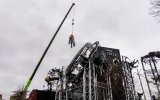Press release - 4 April 2024 |
|
|
The material damage after the fire at Oceana amounts to nearly 500 million
On February 12, 2024, Liseberg's new water world was hit by a devastating fire in which an employee tragically lost his life. The fire also caused extensive material damage. The extent of the damage has been uncertain in economic terms, until now. In connection with the Liseberg Group's quarterly report, a first cost estimate is now established, which means that the project is written down by SEK 484 million.
The write-down is based on the first investigations of the fire and its consequences.
- The damage is in a way immeasurable considering that we lost a friend and colleague in the fire. It is a loss we will never be able to replace. At the same time, we need to think ahead and then the estimation of the material damage is a step on the way towards a possible reconstruction, says Andreas Andersen.
The material damage is extensive but falls short of the initial estimates, which spoke of very extensive damage. The estimate means that the write-down requirement is half as large as first feared.
The estimated write-down of SEK 484 million will now be reflected in the Liseberg Group's accounting and remaining forecasts for the year. There remains, however, certain reservations that the amount may be adjusted as demolition, clean-up and planning for possible reconstruction takes place.
- Simplified, we can now state that there are three central main elements in a possible reconstruction of Oceana: A new attraction tower, a new roof structure and new rides. In addition, a number of fire technical adjustments will probably be made, based on what the ongoing investigations result in, says Andreas Andersen.
Large parts of the basement, the pool facility, technical installations and the entire low-rise part facing Mölndalsvägen with changing rooms, restaurants, shops and foyer have so far been found to be more or less undamaged.
No formal decision on a rebuilding of Oceana from Liseberg's board has yet been made. NCC and Liseberg have worked together in a first investigative reconstruction step to produce a project plan, including proposed budget and timetable, for a possible completion of Oceana. This plan is expected to be completed in the spring and form the basis for further decisions and possible contracting.



